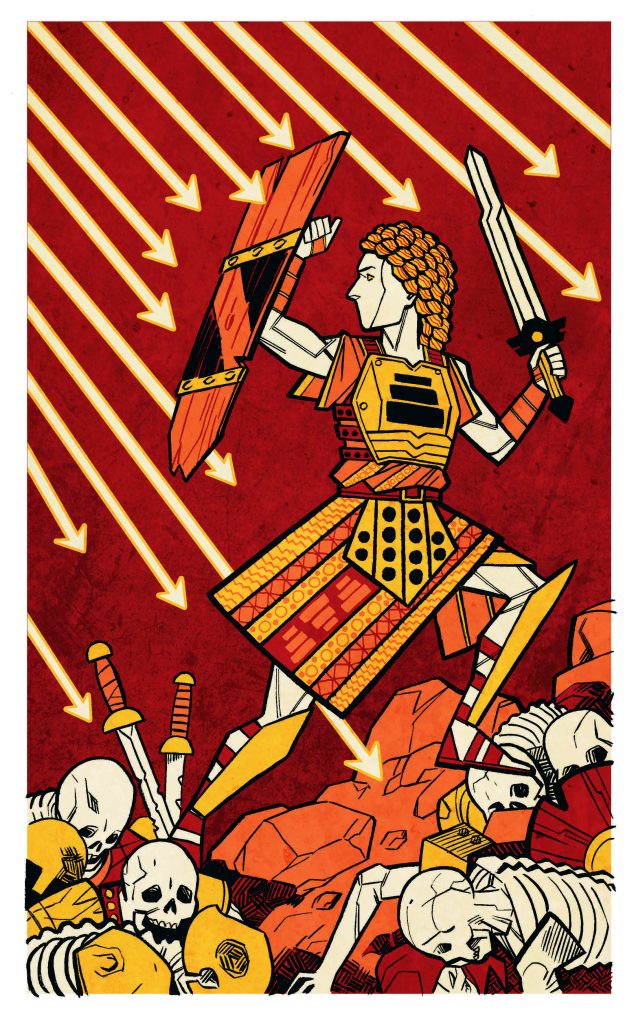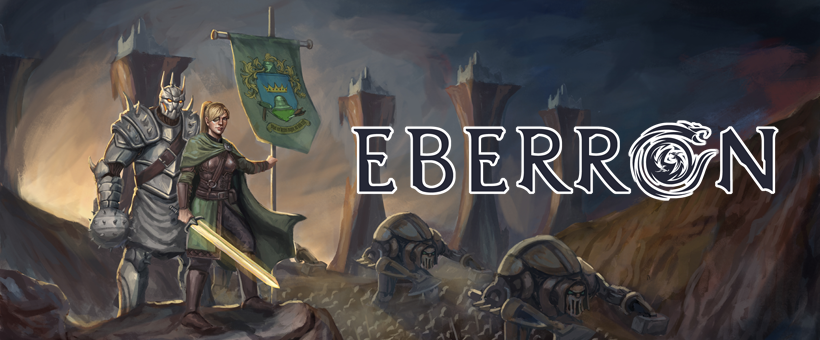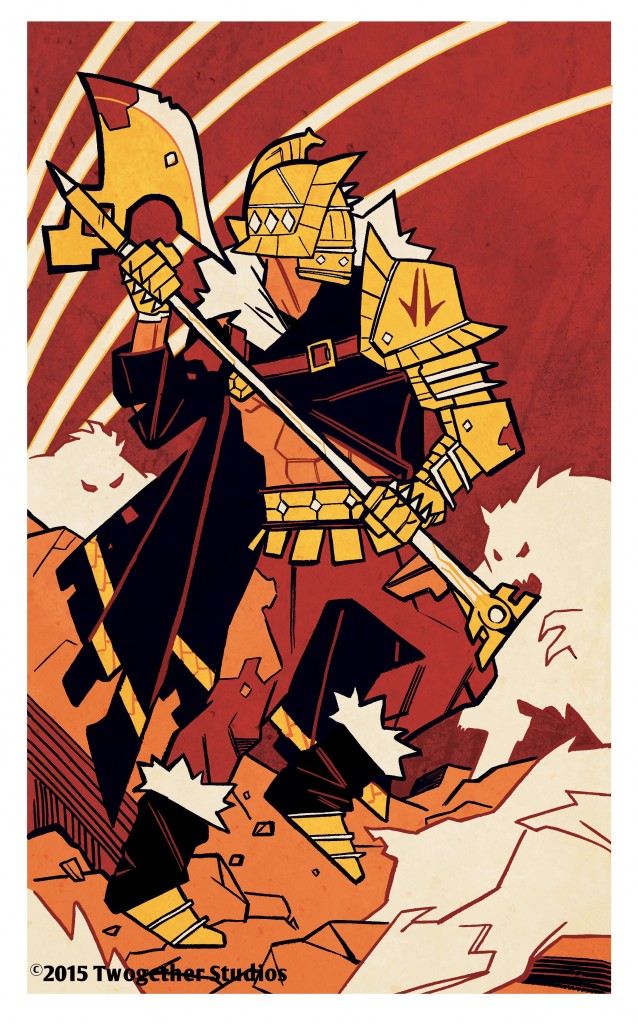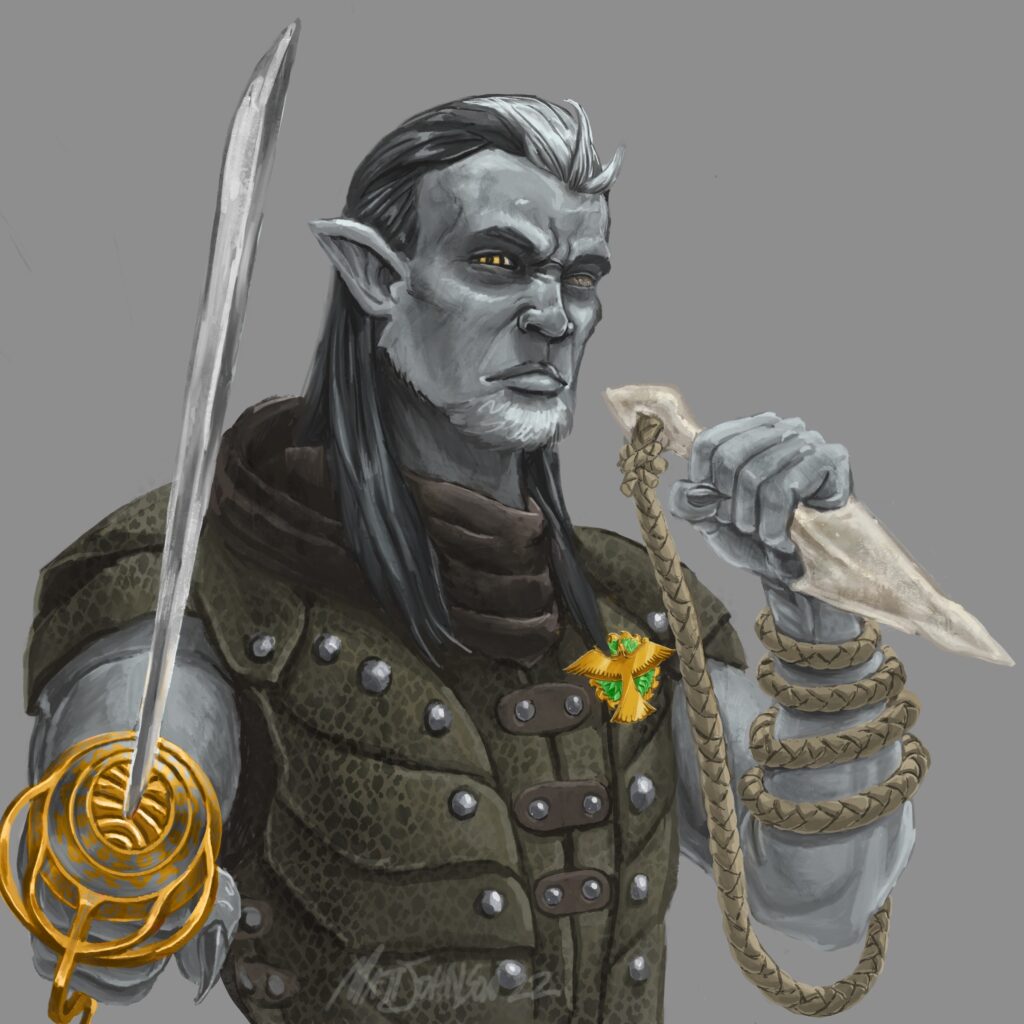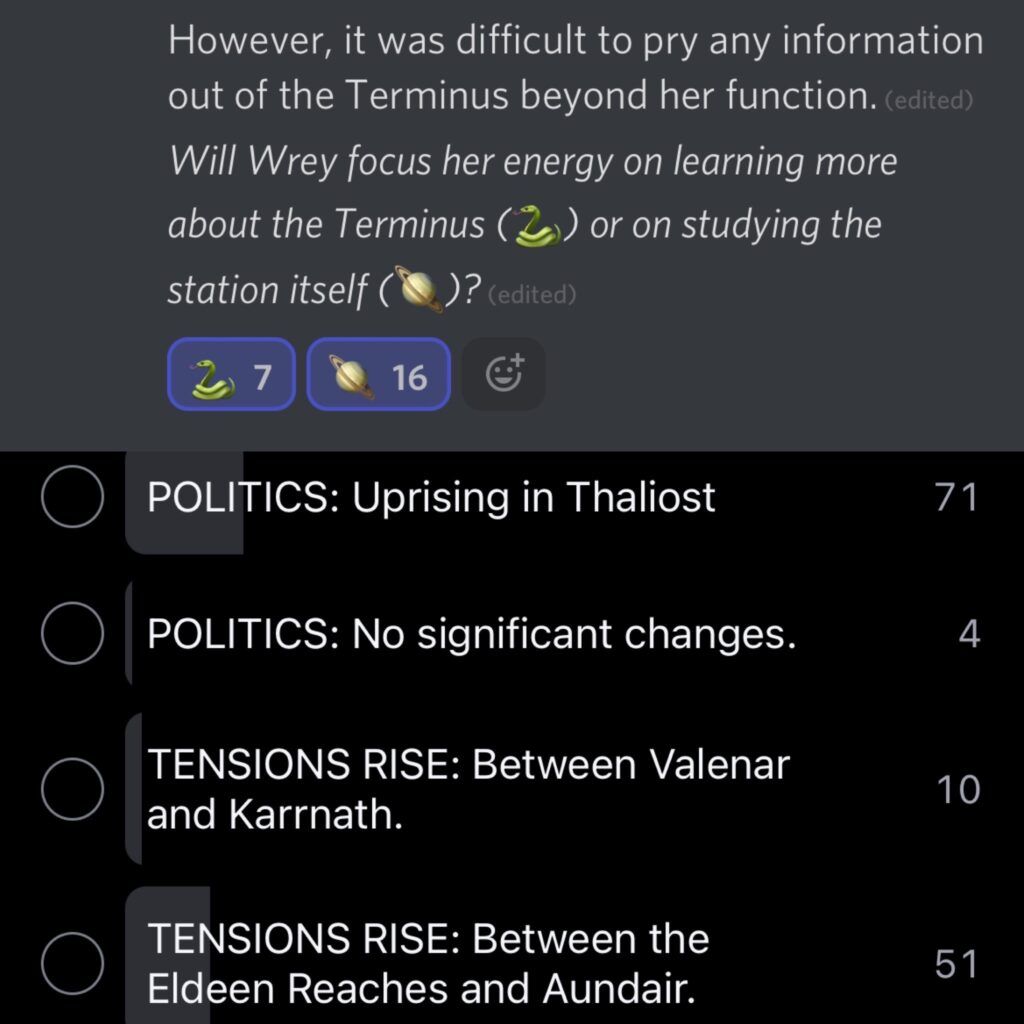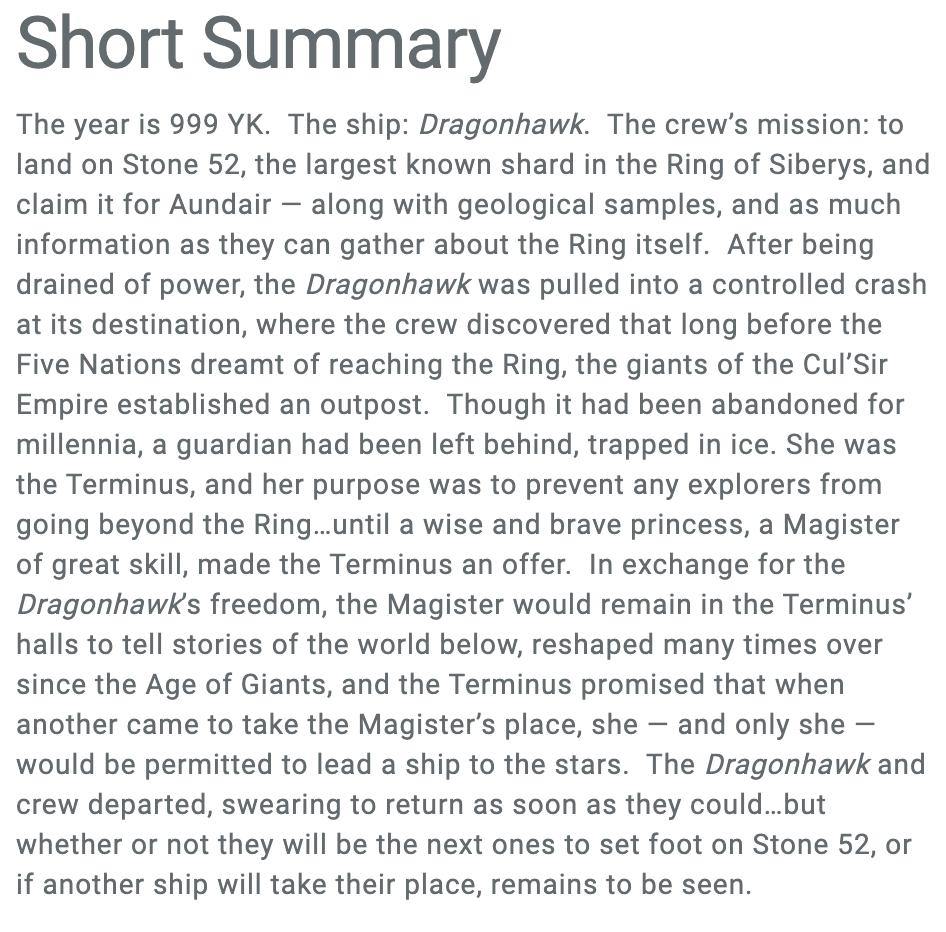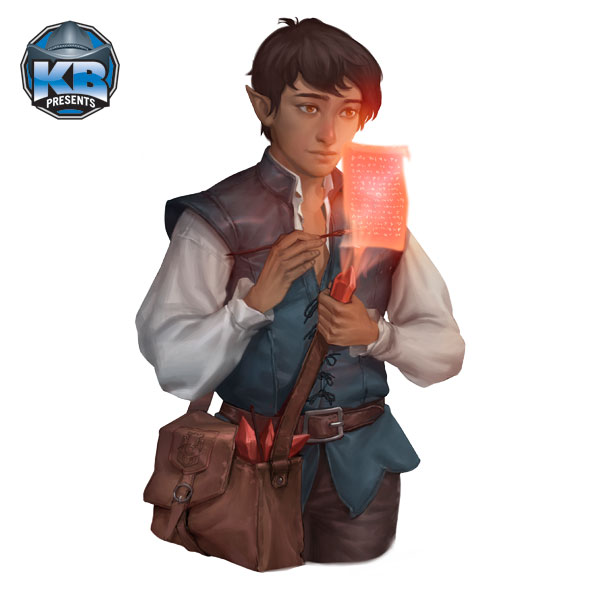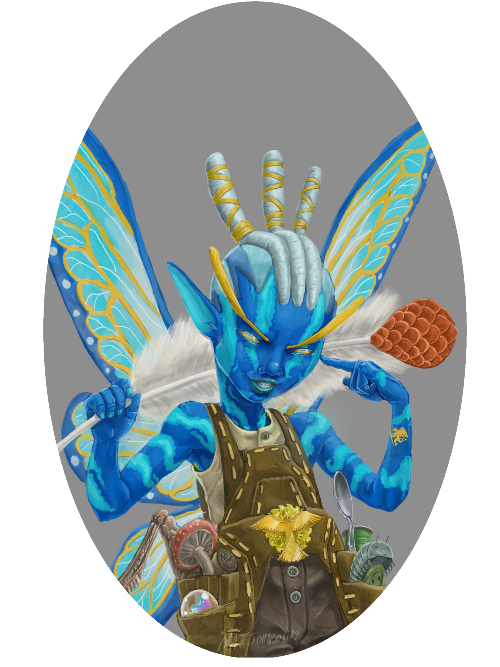
The cosmology of Eberron is often depicted as a vast orrery. Each of the thirteen planes embodies a particular concept, while the material plane is the nexus where all of their ideas are expressed—the realm of life and death, war and peace, story and stagnation. The Astral Plane is the space between and beyond them, embodying nothing. What, then, is the Ethereal Plane and how does it differ from the Astral?
First of all, forget everything you know from canon sources, Eberron or otherwise. This article is about how I use the Ethereal Plane in my campaign, which combines aspects of the traditional Ethereal Plane, the Plane of Shadow, the Shadowfell, and the Feywild… and builds from there. And the first difference is, don’t call it a plane. If you want to move between planes, or between Eberron and the rest of the Multiverse, you’ll travel through the Astral Plane. The Ethereal has no defining concept, and most importantly, it has no independent existence; it’s a shadow cast by another plane. With this in mind, most scholars in Eberron don’t call it the Ethereal Plane; they call it the Ethereal Veil. Think of it as the backstage of reality, a layer that lets you slip outside reality while still being close enough to observe it.
In this article, I’ll start with a general overview of the Ethereal Veil and then delve into two additional ways you can interact with the Ethereal: Haunts and Borders.
THE ETHEREAL VEIL
The Ethereal Veil is a gray shadow of the world. For the most part, the Veil functions exactly as described in canon.
While on the Ethereal Plane, you can see and hear the plane you originated from, which is cast in shades of gray, and you can’t see anything there more than 60 feet away. You can only affect and be affected by other creatures on the Ethereal Plane. Creatures that aren’t there can’t perceive you or interact with you, unless they have the ability to do so. You ignore all objects and effects that aren’t on the Ethereal Plane, allowing you to move through objects you perceive on the plane you originated from. The Ethereal Plane also disobeys the laws of gravity; a creature there can move up and down as easily as walking.
Standing in the Veil, you see a gray shadow of reality. You can see the misty forms of buildings, of trees, of people going about their business… but you cannot be seen or heard, and you cannot affect the adjacent reality. With few exceptions, the Veil is empty. It reflects the adjacent reality, but it holds nothing of its own, and for this reason people rarely stay there for long; there’s no food, no water, and most of the time, no people. As noted earlier, the Veil is an extension of whatever plane you’re currently on. Eberron has an Ethereal Veil, but so does Fernia and so does Syrania; the Veil of Fernia is a gray shadow of Fernia, where the fires are cold and you can pass through the obsidian walls.
Two important facts are that while you can see the images of things in the Material plane—what I’ll call echoes—you can’t affect them and can move through them. This includes the ground beneath your feet. As called out in the description above, “a creature there can move up and down as easily as walking.” This looks like walking, and uses the traveler’s standard movement speed; it’s simply that your feet find purchase wherever you want them to. This also means that you could, for example, just start walking straight down toward the core of the planet. However, you’re walking blind. If you hit a Border or a Haunt, the matter you’re dealing with may suddenly become impermeable, or gravity might reassert itself. And if your magic should fail, the standard rules say “You immediately return to the plane you originated from in the spot you currently occupy. If you occupy the same spot as a solid object or creature when this happens, you are immediately shunted to the nearest unoccupied space that you can occupy and take force damage equal to twice the number of feet you are moved.” If you’re deep in solid rock, that could be a very unpleasant return.
Breaching The Veil
The people of Khorvaire know the Ethereal Veil exists, but there’s limited ways to reach it. The two most common tools are blink (which has a maximum duration of one minute) and etherealness (a high level spell that lasts for up to eight hours). When you enter the Veil, the magic that keeps you there also affects the objects you bring with you. If you blink across the Veil and drop a Shard of Rak Tulkhesh it will return to the material plane as soon as the spell ends… so it’s not an easy dumping ground for cursed objects, nor is it an easy matter to build things there (though if you time things right, you might be able to drop a bomb in there just before it explodes… just ask Three Widow Jane in my Threshold campaign!).
Of course, the Veil isn’t much use if there’s no good way for adventurers to get there. Here’s a few options to consider.
- Blink is one of the powers of the Dragonmark of Passage, and House Orien has been exploring the Veil since the mark first manifested. Throughout its history, the house has experimented with ways to increase the duration of Ethereal jaunts and to take advantage of their connection to the Veil. The oldest tool in their arsenal is the passage salve, an uncommon form of oil of etherealness that only takes 1 minute to apply; it can be used by any creature, but only an heir with the Mark of Passage can activate its power. The Veil torc allows the Passage-marked wearer to cast etherealness as if it was a 3rd level spell, though the duration is only one hour. The Twelve have been continuing to work on this and may well come up with prototype focus items or eldritch machines that can allow groups of people to linger in the Veil—and naturally, they’ll need bold adventurers to test these new developments!
- The Guild of Endless Doors has always been interested in the Ethereal Veil, and they have been working on their own counterparts to Orien’s focus items. The Guild lacks the resources of the Twelve and anything they produce will be available on a smaller scale, but on the other hand, you won’t need a dragonmark to make use of it. And the Royal Eyes of Aundair could be pushing the Guild to fast-track Ethereal tools that can be used by Aundairian spies!
- Ancient Secrets. Humanity may not have mastered the Veil… but the elves of Aerenal are more advanced than the people of the Five Nations, and the dragons of Argonnessen are more powerful still. Sul Khatesh may hold secrets of the Veil that she could share with her Court of Shadows… but at what cost? These paths could provide adventurers—or their enemies—with tools or rituals that support Ethereal exploration.
- Breaking Reality. Reality is a toy in the clutches of the daelkyr. A cult of the Dragon Below might tear apart the Veil or even collapse a chunk of reality into it. Consider Stranger Things!
The Dangers of the Veil
Eberron is a world where the supernatural is part of nature. The Ethereal Veil is part of life, just like air and water—and just like fish adapt to water and birds soar through the air, there are creatures in Eberron who naturally interact with the Ethereal Veil. Phase spiders are a perfect example of this—a predator with a natural ability to cross the Veil at will. While blink dogs currently teleport directly from point to point, I like to take their name literally and imagine them darting through the Veil, if only for a moment.
Night Hags are another possible threat. Along with their nightmares, these fiends have always had free access to the Veil. Every night hag has at least one sanctum hidden in the Ethereal Veil, and most have left other markers and monuments scattered around it. An old iron lantern hidden in the veil might monitor dreams, calling to the hag who forged it when there’s something worthy of attention. A monolith might be a cache where a hag stores the (literal) nightmares she collects—or she might have a stable of equine nightmares hidden in the Veil. Given the vast scope of the Ethereal Veil, adventurers are unlikely to stumble upon hag creations by accident, but night hags can definitely be a source of deadly traps or enigmatic elements waiting to be found across the Veil.
Another traditionally Ethereal-dwelling species are the Ethergaunts. Originally they’re presented as an alien species with an advanced civilization in the Ethereal Plane. Canon lore suggested that they were tied to the Daelkyr. Personally, I’d take a different approach. I don’t want a powerful civilization in the Veil, and the Daelkyr have enough going on. But I love the idea of eerie alien scientists who are watching us from beyond the Veil—who could be in the room with you right now. I love the thought of an Ethergaunt triggering a series of bizarre and seemingly impossible events—a man killed, the pieces of his body discovered in different locked vaults—in pursuit of fear, or even of children’s toys appearing from nowhere as a way to trigger joy. With this in mind, I’d tie the Ethergaunts to Mordain the Fleshweaver. Mordain never leaves Blackroot. But I love the idea that he’s created a corps of agents who are active all over the world… but active on the other side of the Veil. I love the idea of a man being questioned about an impossible murder, and when the Medani inquisitve casts see invisibility they are shocked by the hideous creature watching the interrogation from across the Veil. And the point of this approach is that each ethergaunt has its own task. It’s not introducing another organized enemy; it’s an army of invisible terrors, each pursuing a unique and unpredictable goal as they gather data for their creator. The final piece of this puzzle is how Mordain created the ethergaunts. Were they made from raw materials? Or did Mordain kidnap Orien heirs—beneath their armor, do ethergaunts have a bizarrely evolved form of the Mark of Passage?
Beyond this, part of the role of the Veil is to be undiscovered and unknown. It is as vast as the reality itself, and there may be powers within it that humanity has simply never encountered. It’s an alien world waiting to be discover that is all around us, just beyond what our eyes can see.
All this deals with the broad swath of the Veil, the gray shadow of the reality. But there are places where the Ethereal takes a more concrete form; the two most common of these are Haunts and Borders.
ETHEREAL HAUNTS
As described in this article, most ghosts in Eberron are “souls trapped between Eberron and Dolurrh, driven to complete their unfinished business or held fast by emotions or memories they can’t let go. While they have at least some of their memories from life, most ghosts aren’t fully aware of their condition or the passage of time, and they generally can’t retain new information.” Let’s call these restless spirits lingering ghosts.
When a lingering ghost is bound to a location—typically due to traumatic events that occurred there—it resides in the Ethereal Veil. Most such ghosts aren’t aware of the passage of time. They linger in the ether until something pulls them across the Veil, typically something tied to the anchors keeping them from Dolurrh. Most of the time, a lingering ghost simply drifts through the shadows of the Ethereal Veil, endlessly retracing its steps until something triggers a reaction. However, a lingering ghost driven by exceptionally powerful emotions or memories can reshape the Veil, imposing its own memories upon the the shadows of reality. So it may be that the ir’Halan Manor is a crumbling ruin stripped by looters long ago—but if a warlock blinks into the Veil, they find themselves in a vibrant replica of ir’Halan Manor at its height. There’s a fire in the hearth, music in the air, and guests mingling and murmuring. This is a Haunt—a recreation of the night that Lady ir’Halan was betrayed and murdered. It’s here that her ghost dwells, endlessly recreating that final night. Ethereal travelers can interact with objects and effects that are part of the Haunt; someone who blinks into the memory of ir’Halan Manor will find that they can’t walk through the walls and that normal gravity is in effect, and that they can take a drink from the waiter passing by. However, for the most part the elements of a Haunt are only real within the Veil. A traveler can take a drink from a waiter and they can savor the flavor of it… but when they blink back to reality, the glass fades from their hand and the wine itself fades from their system. In many ways it’s like a powerful illusion; a popular arcane theory asserts that many illusion spells function by shaping the Veil and pulling it into reality. But while you’re in the Veil, a haunt seems real.
The classic Haunt is tied to a single ghost; if that ghost is destroyed or laid to rest, the Veil will return to its gray shadow of reality. However, a Haunt can also be shaped by a mass surge of emotions or pain so powerful that they leave psychic scars on reality. The site of a massacre, a prisoner of war camp, an orphanage… all of these can leave Haunts on the other side of the Veil. Where the ghost Haunts often perfectly recreate a moment from the past, traumatic Haunts are often more surreal. If you’re in the ruins of a village destroyed by brutal soldiers during the Last War, the Haunt on the other side of the Veil could be haunted by shadowy creatures that blend the traits of Brelish soldier and beast, using the statistics of worgs; the Veil remembers the terror and brutality, not the precise details. As with ghost Haunts, traumatic haunts feel real to people who enter the Veil; travelers can’t move through objects, people can’t walk through the air, and threats can inflict real damage.
While Haunts are usually tied to locations, a lingering ghost can also be tied to an object… or even to a particular event, such as a song. In such instances the ghost won’t completely transform the Veil, but it will leak elements of its anchoring trauma into the environment.
See invisibility is a 2nd level spell and allows the caster to peer beyond the Veil. As such, it’s an important tool for mediums and exorcists; as it’s a gift of the Mark of Detection, House Medani inquisitives may be called in to investigate suspected Haunts.
Beyond ghosts and trauma, there’s another force that can create Haunts within the Veil: the Overlords of the First Age. An unbound overlord can shape reality; a bound overlord might reshape the Veil in its image. The most logical place for this would be around an Overlord’s prison. If you cross the Veil near the prison of the Wild Heart, you might find that the echoes of the woods are not only solid but writhing and aggressive. The Veil in the vicinity of one of Rak Tulkhesh’s prison shards might be stained with blood and the refuse of recent battle… a foreshadowing of Rak Tulkhesh’s desires. Another possibility is that the devotions of a Cult of the Dragon Below could channel the influence of their overlord to shape the Veil in their place of power. Sul Khatesh’s Court of Shadows imagine a magical kingdom that exists beyond the world; it could be that through their devotion, a powerful chapter of the Court could create this shadow-kingdom on the other side of the Veil. If so, the question is whether Sul Khatesh allows her cultists to cross the Veil, or if they simply have the ability to SEE these umbral spires rising behind reality when others cannot. In a twist—in part because otherwise it would be all too easy for House Medani to monitor cults—in my campaign Overlord Haunt effects can’t be seen by see invisibility, though true seeing will reveal their presence; just as rakshasa resist low level spells, the influence of the overlords isn’t so easily revealed.
Lingering Ghosts and Shades
Lingering ghosts usually don’t know that they’re ghosts. They linger because they’re trapped in a particular moment or by a powerful anchor, and they interpret all events through that emotional lens. Often when dealing with adventurers, a lingering ghost will fixate on one or more adventurers who bear some similarity to characters from their own personal drama—recognizing the bard as the lover who spurned them, or the rogue as the cousin who ruined them—and completely ignore the other adventurers. They generally can’t be reasoned with and simply won’t hear things that don’t fit their narrative. Persuasion and Intimidation often have little impact on them, because they essentially can’t change their minds… unless the speaker is actually invoking part of the ghost’s story, in which case a check might have advantage.
Lingering ghosts can use the standard ghost stat block from the Monster Manual, but they aren’t visible on the material plane while in the Veil; there could be lingering ghosts around you right now, but you’ll never know unless something pulls them across the Veil. Also, because lingering ghosts don’t know they’re ghosts, they don’t always take full tactical advantage of their capabilities in combat. They may use Horrifying Visage instinctively, manifesting their horrifying visage in a moment of anguish or rage. Possession is often used to seize control of an adventurer who has some similarities to the ghost’s living form; the ghost doesn’t recognize that they are possessing someone and believes the body is their own. However, the classic ghost stat block is only a starting point. Depending on the ghost’s scenario and the strength of its anguish, it could be a simple poltergeist or even something as powerful as a dullahan. While the core stat blocks are a good place to start, part of what makes encounters with lingering ghosts interesting is to vary them based on the story and unique nature of the ghost.
- To harm the ghost, you must recreate the circumstances of its original death. The man who died in fire might be immune to all damage types except fire. A ghost who died in a fateful duel could be immune to all physical damage except from rapiers, and vulnerable to damage from the rapier that actually killed them. If a ghost has such extreme resistances, you might reduce the power of its withering touch—adventurers will need time to realize their attacks aren’t working and find an effective solution.
- The ghost can’t attack as an action. Instead, it has three legendary actions it can use to attack an enemy who attacks it. It can taunt and provoke, but if people simply ignore it, it can’t initiate violence.
- Instead of targeting everyone within 60 feet, apply the effects of Horrifying Visage to victims of the ghost’s physical attack. When the ghost touches a target, the victim has a flash of its anchoring trauma; this is what causes the fear. The aging effect could be removed or reduced to 1d4 years per attack, reflecting the sheer shock to the victim’s system.
- The ghost has no physical attack, Horrifying Visage, or Possession. However, it can cast phantasmal killer at will, drawing the victim into the nightmare of the ghost’s own death. It will typically focus on one person at a time, ignoring all others while it psychically crushes its chosen victim.
- Instead of Possession, the ghost has the power to draw a single victim into the Ethereal Veil. The victim’s physical body remains on the material plane, but their consciousness and likeness are pulled into the Veil, where they can interact with it as if they were physically present. So the victim’s companions can see the character struggling with an unknown foe, but they can’t perceive the ghost or interact with it in any way.
- Instead of Possession, the ghost can cast dream, targeting creatures across the Veil. It may target someone it identifies with, forcing them to suffer visions of the ghost’s demise, or it could target someone it blames for its tragedy.
- Rather than inflicting necrotic damage, a ghost’s attack could reflect something about their life. A duelist could inflict slashing damage with a spectral rapier; a pyromancer could inflict fire damage with a burning touch; a spurned lover could inflict psychic damage, literally breaking the heart of their victim.
Taking a scenario like the ir’Halan manor, the house may appear to be full of people, and the people in these crowd scenes aren’t full ghosts. They’re shades, memories plucked from the life of the lingering ghost. Often shades have no real existence. They’re essentially manifestations of the phantasmal force spell. Any direct attack or defense against such a shade should be resolved with a Wisdom saving throw against the spell DC of the lingering ghost; a shade’s attack deals 1d6 psychic damage. More potent shades could use the statistics of a shadow or a poltergeist; alternately, they could use the statistics of other creatures (such as the worg-soldiers in the massacre haunt). Like the lingering ghost, shades are bound to play out their roles and may not use abilities they possess if they don’t fit their role in the story.
A Haunt reflects the anchors that are binding the ghost to the world, which may not be related to the actual moment of their death. The ir’Halan manor scenario may reflect the night Lady ir’Halan was murdered, but the haunted Cannith foundry may reflect the day that Castar d’Cannith murdered his father or ruined his partner; even if Castar died a natural death, it’s his intense guilt over what he did in the foundry that binds him to the world. In dealing with anchors, consider the following questions.
- Was the ghost the victim in the scenario—they were murdered, financially ruined, framed for a crime they didn’t commit? Or are they anchored by guilt for the wrongs they inflicted on others?
- If the ghost was a victim, do they want bloody revenge? If they don’t want blood, do they want the wrongdoer to feel remorse or to publicly acknowledge what was done? Or do they just want the truth to be known by the general public?
- If the ghost was a perpetrator, do they want to make reparations for the crimes that they committed? Do they want the truth to be known? Or do they refuse to acknowledge that they have done something wrong, and they actually want any lingering evidence of their guilt to be wiped out?
- Another option is that the ghost died with a task unfinished. This could be very concrete—a letter that was never delivered, an arcane experiment that was never completed, a buried treasure that was supposed to be found. Or it could be more abstract—they wanted a town to prosper, a child to have a good home.
Loosening an anchor could be a task for an altruistic group of adventurers who want to lay a ghost to rest. However, it can also simply be used to set the tone and parameters of a haunt. A murdered many may not be able to rest until the entire family line of his murderer has been exterminated. The adventurers may consider this extreme and ruthless desire to be vile and cruel; the point is that the ghost’s haunt may reflect their hunger for bloody vengeance, and if one of the player characters is part of the murderer’s bloodline, it could drive the story.
THE BORDER ETHEREAL
The material plane is influenced by all of the other planes. Where this influence is especially strong, you find manifest zones. Traits of the outer plane bleed into the material, and planar energies may produce unusual flora or fauna. However, often manifest zones aren’t obvious to the naked eye. It’s the influence of Syrania that makes it possible for the towers of Sharn to scrape the sky, but if you never try flying, you might never notice its effects.
This changes when you cross the Veil. Where another plane touches the material, you’ll find the Border Ethereal—a dramatic blending of the two realms. The Border Ethereal generally reflects the reality of the material plane in its layout and structure; when you blink into the Veil from a tower in Sharn, you’ll still be in a tower with roughly the same shape. But the cliffs over the Dagger are now formed of thick cloudstuff. The towers themselves are formed of crystal and mist. You can see shadow angels circling in the skies, along with whorls of living cloud-stuff (the minor air elementals mentioned on page 152 of Rising From The Last War).
Likewise, imagine a Fernian manifest zone in the King’s Forest of Breland. In the material plane, this stretch of jungle is unseasonably warm and prone to flash fires. But when you cross the veil, you find that same forest, except that the trees are always on fire and yet never consumed. Mephits leap from tree to tree, delighting in the flames. While the trees are never consumed, their flames will burn any travelers who touch them, and the stifling heat is deadly to mortals.
In short, the Border Ethereal takes on some of the elements of the traditional Feywild (Thelanian Borders) and Shadowfell (Borders with Dolurrh or Mabar), while adding a host of other blended realms. However, the stories of the Border Ethereal are smaller in scope and scale than the stories of the planes; you might make a deal with a terrifying hag in a Thelanian Border, but if you want to deal with an archfey or dance in the Palace of the Moon, you need to go to Thelanis itself.
You can use any of the methods described in Breaching the Veil to reach a Border, but sometimes there are other options unique to the manifest zone. Dance in the ring of mushrooms when Rhaan is full and you might end up on the other side of the Veil. Sacrifice something you love in fire, and your grief might drag you across the Fernian border. These passages shouldn’t be easy—it’s not like the locals should have regular commerce with the Border Ethereal—and most zones don’t have them, but they can provide ways for adventurers to have an adventure across the Veil without having to spend a fortune on oil of etherealness, and a way to have a taste of the planes without entirely leaving home.
Denizens of the Border Ethereal
One of the major things that distinguishes the Border Ethereal from the planes they’re connected to are the inhabitants. The Border Ethereal resembles a blend of the two planes, and people can see shadows of the inhabitants on both sides of the veil. In the example given above, the angels that can be seen in the skies of the Border Ethereal in Sharn aren’t present in the border; they’re shadowy images of the denizens of Syrania, flying through their own skies. The borders of Shavarath appear war-torn and you may see misty images of conscripts and fiends, but the damage you see in the environment around you wasn’t actually caused by recent action. So for the most part, the Border Ethereal is empty and relatively safe for travelers. However, there are exceptions.
- Anchors. Some Ethereal Borders are home to an anchoring entity, who plays the same basic role as a lingering ghost does with a haunt. This is usually a powerful immortal from the associated plane, but it’s rarely one of the most powerful beings in that plane. A Mabaran Border could be held by a Ultroloth servant of the Empress of Shadows, or a powerful banshee sworn to the Queen of All Tears. A forested Thelanian border might be bound to the tragic story of an exceptional dryad who is a daughter of the Forest Queen, but you won’t find the Forest Queen herself on the Border. A Lamannian Border might be anchored by a massive megafauna beast, while a powerful beholder might watch the world from the Border Ethereal. If it’s possible to pass through a border, the Anchor Lord may control the passage. Anchor lords typically can’t leave their borders, but those with an interest in the material might well recruit mortal agents; this could be an interesting, smaller-scale patron for a warlock, if a campaign is based in a particular region.
- Denizens. Sometimes Borders will have a small population of native creatures from the associated plane. Mabaran Borders are often home to shadows, and sometimes when powerful undead are destroyed in Mabaran zones they linger in the Veil instead of going directly to the Endless Night; a slain vampire might continue to haunt their castle as a wraith in the Border Ethereal. Restless souls can linger on the edge of Dolurrh. A Thelanian Border might have a small population of native sprites… and a Xoriat Border may be home to aberrations. Again, Borders generally aren’t crowded, and the natives will be outnumbered by the misty reflections of the people on the material plane… but some are inhabited.
- Shades. As with Haunts, Borders can manifest illusions relating to their story—creatures that seem so real that they can inflict slight damage, but which have no ongoing existence or logical ecology surrounding them.
- Travelers. Especially in a Border with no Anchor, it’s always possible you’ll encounter other travelers. Set aside Night Hags, Chamber observers, Lords of Dust, or Ethergaunts and you could still find Orien heirs or Royal Eyes of Aundair using the latest tools from the Guild of Endless Doors to spy across the Veil. But in general the Ethereal Veil is a place you pass through—not a place where mortals dwell.
Passing Through
The Ethereal Veil extends from the plane its attached to, but no farther. There’s no Deep Ethereal, no curtains to other planes; the Astral Plane is the primary corridor for travel. However, the Borders are where planes come together, and it may be possible to move between material and the connected planes in such places. Anchor Lords often have the power to open passages for travelers. Otherwise, passages are often well hidden and may require particular actions to open. There might be a gate of rusted iron in a Shavarath Border that only opens when blood is spilled in anger, or a clearing in Thelanis that provides passage when adventurers tell the story of their destination.
The Effects of the Planes
Typically the Border Ethereal resembles the overlapping region in the Material Plane—the material foundation—transformed to reflect the influence of the outer plane. The Lamannian Border of a city will be overgrown; the Shavaran Border of a city will be shattered by war. The misty echoes of the creatures of the material plane can be seen moving around, and occasionally echoes of extraplanar beings can be seen as well.
A crucial feature of the Border Ethereal is that its structures are solid. Explorers can’t walk through the burning trees of a forest in a Fernian Border, or the fortified walls of a Shavaran Border. Gravity is also usually in effect in Borders, so people can’t walk through the air. Here’s a few elements you could find in the Border Ethereal; the planar traits referred to are described in Exploring Eberron.
- DAANVI. Angles feel sharper. People naturally move to an underlying rhythm; the Plane of Truth and No Chance properties (ExE) are usually in effect. Structures or plants may be formed from metal, perfect and precise. Anything naturally chaotic—the patterns of ivy, clouds—are structured and reliable. Misty images of marching modrons can occasionally be seen.
- DAL QUOR. The destruction of Crya severed Dal Quor’s direct connections to the material plane, and just as there are no manifest zones, there’s no Border Ethereal between Dal Quor and Eberron.
- DOLURRH. At a glance, the Border of Dolurrh looks just like the rest of the Ethereal Veil—a grey echo of the material plane, perhaps with a little more mist clinging to the edges. Shades often linger in Dolurrhi borders. Some are husks whose memories have been stripped away, vague grey outlines of people. Others are the spirits of people who have recently died in the area—not so restless as to become lingering ghosts, yet still clinging to the world, unwilling to slip away. Like lingering ghosts, such spirits usually can’t comprehend their situation—but they know they have somewhere to be, something to do. The Dolurrh Border is a dangerous place; the Eternal Entrapment and Inevitable Ennui traits are in effect, and anyone who lingers too long can get trapped forever.
- FERNIA. First and foremost, FIRE. Things burn without being consumed. Bodies of water may be replaced by magma or pure fire. Obsidian, brass, and igneous stone are common materials, and the air may be filled with smoke and ash. The Deadly Heat property of Fernia is in effect.
- IRIAN. The Pure Light property of Irian means that there’s no darkness in an Irian Border. Colors are bright and cheerful. Plants and wildlife appear healthy and vibrant, and things seem fresh and new. Most Irian zones also have the Life Triumphant property; it’s a good place to take shelter when you’re pursued by undead.
- KYTHRI. A Kythri border has a general resemblance to its material inspiration, but it’s always slowly changing. As one element drifts further away from the aspect of the material that cast it, another will drift back toward it; so again, overall, it resembles the material plane but is constantly shifting. Building materials are constantly in flux; if there’s a row of houses, one might be made from stone and another made from straw; give it an hour and they could both be made from hard candy. The Kythri border has the Constant Change and The Odds Are Odd properties.
- LAMANNIA. Natural features are exaggerated and weather effects are more dramatic. If the border is in an urbanized area, it will resemble the Titan’s Folly layer of Lamannia: buildings will be overgrown, with roots cracking foundations and nature reclaiming the land. Even if there are no denizens in the Border, shadows of massive beasts can be seen moving through the land. It has the Primordial Matter property of Lamannia.
- MABAR. The Eternal Shadows and Necrotic Power properties of Mabar can be felt in the Border Ethereal, consuming bright light and bolstering undead. The landscape resembles the material foundation, but plants are withered and dying and structures are decrepit and crumbling; it’s a vision of ruin and entropy. Shadows congregate in Mabaran Borders, often following the movements of people in the material world; sometimes their movements can be seen in mortal shadows.
- RISIA. Everything is either formed from ice or encrusted with it. Liquids are frozen. Risian Borders have the Lethal Cold and Stagnation effects. There are rarely any creatures in a Risian Border; it is cold and empty.
- SHAVARATH. Imagine the world at war. The Border resembles its material foundation, but cast through the lens of a bitter, prolonged conflict. Some buildings are ruined, others are fortified. There are craters and smoldering fires. While occasionally there are shades battling or misty visions of fiends and angels, more often than not it feels like an active war zone, as though the enemy could strike at any moment, but no one ever does. This Border has the Bloodletting property of Shavarath.
- SYRANIA. Syranian Borders take different forms, reflecting the aspects of the plane that manifest in the connected zone. In the Border of Sharn, the Unburdened property is in effect and all creatures can fly; as mentioned earlier, structures are formed of crystal and mist and animate clouds drift around. Another Border might be more grounded, but have the Gentle Thoughts and Universal Understanding properties, allowing all spoken languages to be understood.
- THELANIS. Every Thelanian Border has a story, and builds on the material foundation to sell that story. In one forest, the woods may grow darker and deeper, promising that wolves and far deadlier things lurk just off the path; in another forest, the trees may be full of dancing lights, with misty images of satyrs dancing in the groves. A city may become more beautiful and magical, or it could seem cruel and oppressive if the driving story is one of a bitter tyrant. The story of the Border will be well known to anyone who lives in the region. In the case of the bitter tyrant, the actual rulers may take pains not to resemble the cruel leader of the tale… or it may be that the Border seeps into reality and drives the locals to be cruel. Storybook Logic is in effect, and where there are fey, Words Have Power.
- XORIAT. There is no predicting what a Xoriat border will look like, but it’s always strange and usually disturbing. One Xoriat border may perfectly resemble its material foundation until you realize that all the structures are actually made of flesh and blood; the buildings quiver when you approach, and that low moan isn’t the wind. In another, writhing tentacles stretch up from the earth, burrowing through buildings and grasping any travelers who come to close. Mirrors ripple and reveal unpleasant truths. Colors are disturbing and gravity is unreliable; the Strange Reality property of Xoriat is always in effect.
WHAT ABOUT…
- The Plane of Shadow? In my campaign, the Ethereal Veil and the Plane of Shadow are two different words for the same thing. The Feywild is a term that could be used to describe Thelanian Borders, while the Shadowfell could describe Mabaran or Dolurrhi borders.
- Plane Shift? The spell Plane Shift can’t transport you to the Ethereal Veil, as it’s not a plane.
- Secret Chest? The spell Secret Chest is tied to the Astral Plane, not the Ethereal Veil—as previous discussed in the Subspace section of the Astral Plane article. In general, Ethereal travel takes you sideways to your current location. Any magical effect that creates a new extradimensional space or that connects planes together should be tied to the Astral Plane.
- Wild Zones? The Wild Zones of Sarlona are exceptionally powerful manifest zones—often described as planar beachheads. My personal inclination is that Wild Zones don’t have Ethereal Borders—that the reason they are wild is that the Border Ethereal normally acts as a buffer between the planes, but has here collapsed and fused them directly together. This reflects a dramatic breakdown of the cosmic design and I’d also say it’s the source of the Reality Storms—raging surges of planar energy. How could such a thing happen? It’s a mystery, but it could well be tied to the Sarlonan Overlord Ran Iishiv the Unmaker, infamously driven to tear down reality; the Unmaker may have begun this process by tearing away the Ethereal Veil.
- The Radiant Citadel? In my campaign, I’d put the Radiant Citadel in the Astral Plane. Personally, I’d make the civilizations of the Citadel legacies of previous incarnations of the Material Plane, just like Githberron. A key question would be if all or some of the civilizations came from the same world, or if each one comes from a different echo of the current reality. It could well be that the Citadel offered sanctuary to the Githyanki, but they spurned it. If I went with this approach, another important question would be the role of the Concord Jewels. Does each jewel hold a preserved version of the civilization even though its world has been lost? Or do the civilizations now only exist in the Citadel itself, while the Jewels take you to the broken worlds that are lost in the Maze of Realities?
That’s all for now! Feel free to discuss the topic in the comments, but I won’t be answering questions. If you’d like to ask me questions on this or other topics, check out my Patreon! And thanks to my patrons for making these articles possible.

 Unlock with Patreon
Unlock with Patreon